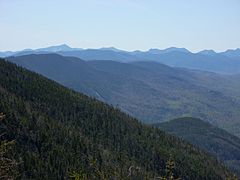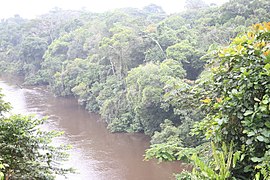Ogonkai: Difference between revisions
No edit summary |
No edit summary |
||
| Line 63: | Line 63: | ||
|area_km2 = 1303126.62 | |area_km2 = 1303126.62 | ||
|area_sq_mi = 503140 | |area_sq_mi = 503140 | ||
|population_estimate = | |population_estimate = 64,849,014 | ||
|population_census = | |population_census = | ||
|GDP_nominal = $ | |GDP_nominal = $3.011 trillion | ||
|GDP_nominal_per_capita = $ | |GDP_nominal_per_capita = $46.430 | ||
|Gini = 57.76 | |Gini = 57.76 | ||
|currency = Chyo (Ȼ) | |currency = Chyo (Ȼ) | ||
| Line 75: | Line 75: | ||
|cctld = | |cctld = | ||
|calling_code = <!--e.g. [[+1]], [[+531]], [[+44]], etc--> | |calling_code = <!--e.g. [[+1]], [[+531]], [[+44]], etc--> | ||
|GDP_nominal_year=2023|Gini_change=increase|Gini_year=2022|leader_title12=Representative of Fukugan District|leader_name12=Niiro Arimichi}} | |GDP_nominal_year=2023|Gini_change=increase|Gini_year=2022|leader_title12=Representative of Fukugan District|leader_name12=Niiro Arimichi|population_estimate_year=2035|legislature=}} | ||
'''Ogonkai''', officially the '''Council of Ogonkai''' or the '''Ogonkaic Council''', is a country in northern [[Audonia]]. To the west and south, it is bordered by [[Jazee]], [[Kandara]] and [[Ankivara]]. To the east, it is bordered by [[Wonjin]] and [[Ugioh]]. It comprises an area of 1,303,126km<sup>2</sup> (503,104 sq mi) spread among its main continental landmass | '''Ogonkai''', officially the '''Council of Ogonkai''' or the '''Ogonkaic Council''', is a country in northern [[Audonia]]. To the west and south, it is bordered by [[Jazee]], [[Kandara]] and [[Ankivara]]. To the east, it is bordered by [[Wonjin]] and [[Ugioh]]. With a population of 64 million, It comprises an area of 1,303,126km<sup>2</sup> (503,104 sq mi) spread among its main continental landmass and hundreds of islands. | ||
While lacking a federal capital, the National Council meets in the historic city of Kinhara. Minakyo is the nation's most populated city with an estimated population of | While lacking a federal capital, the National Council meets in the historic city of Kinhara. Minakyo is the nation's most populated city with an estimated population of six million; other major hubs include Aoyama, Kinhara, Yamatake and Sugihara. Divided among 12 districts and 3 special territories, roughly half of the nation's territory is extremely mountainous, concentrating its highly urbanized population and robust industry to its coastal areas and major islands. | ||
While the territory that now comprises Ogonkai has historically been sparsely settled with major population centers instead concentrating south in [[Daxia]] and its neighboring territories, the first of many migrations towards the territory commenced roughly 13,000 years ago, with evidence of the first human habitation dating back to 20,000 years ago. After these migrations, widespread habitation of the territory began. Millennia later, as a way to defend against the increasingly more common [[Myanga Ayil Khanate]] incursions throughout the region, the villages and small fiefdoms that dotted the territory began crystallizing into their own independent kingdoms in the late tenth century. | While the territory that now comprises Ogonkai has historically been sparsely settled with major population centers instead concentrating south in [[Daxia]] and its neighboring territories, the first of many migrations towards the territory commenced roughly 13,000 years ago, with evidence of the first human habitation dating back to 20,000 years ago. After these migrations, widespread habitation of the territory began. Millennia later, as a way to defend against the increasingly more common [[Myanga Ayil Khanate]] incursions throughout the region, the villages and small fiefdoms that dotted the territory began crystallizing into their own independent kingdoms in the late tenth century. | ||
| Line 163: | Line 163: | ||
These writers formed the People's Influence Bloc and, as more of the urban middle class joined, it swelled in size to become a significant organization. It began organizing protests across Ogonkai's major cities and industrial centers. At its peak, the Bloc rallied around 25.000 people spread out across the country (by this time, Ogonkai had around a million inhabitants). Mounting pressure on production centers forced the upper classes to back the protests, which forced the Royal Council to negotiate with the Bloc. | These writers formed the People's Influence Bloc and, as more of the urban middle class joined, it swelled in size to become a significant organization. It began organizing protests across Ogonkai's major cities and industrial centers. At its peak, the Bloc rallied around 25.000 people spread out across the country (by this time, Ogonkai had around a million inhabitants). Mounting pressure on production centers forced the upper classes to back the protests, which forced the Royal Council to negotiate with the Bloc. | ||
The result of these negotiations were the establishment of twelve Regional Councils that served the 12 regions. These | The result of these negotiations were the establishment of twelve Regional Councils that served the 12 regions. These councils were voted for directly by eligible voters, and they served an advisory role to each region's monarch. They could also veto any decisions made by the monarch if a 75% (9-3) majority within the Regional Council was reached. While this was an important step in modernizing Ogonkai's political system, the powers of the Regional Councils were limited; modeled somewhat after Alstin's own voting laws, only literate males above the age of 25 had the right to vote. This drastically skewed the voting pool in favor of the upper classes, perpetuating their influence in the political system. This remained a point of contention between the middle and upper classes throughout the century and was the motivation for many episodes of popular unrest and confrontation that would happen afterward. | ||
As industrialization intensified, the nation's population continued to grow at an increasingly accelerated rate. Beginning in 1815, many resource shortages (including manufacturing components and food) were observed. In a 1819 9-3 Royal Council decision, it was decided that Ogonkai would pursue a policy of colonization over the yet unclaimed Southern lands with the stated purpose of "promoting an organized environment for urban expansion and extraction of resources to match the growing population". The first of such expansions happened in 1820, followed by successive expansions in 1832 and 1846. While an stated aim of the project was to lighten the load of urban centers by promoting settlement in these new lands, influx was minimal and by 1890 | As industrialization intensified, the nation's population continued to grow at an increasingly accelerated rate. Beginning in 1815, many resource shortages (including manufacturing components and food) were observed. In a 1819 9-3 Royal Council decision, it was decided that Ogonkai would pursue a policy of colonization over the yet unclaimed Southern lands with the stated purpose of "promoting an organized environment for urban expansion and extraction of resources to match the growing population". The first of such expansions happened in 1820, followed by successive expansions in 1832 and 1846. While an stated aim of the project was to lighten the load of urban centers by promoting settlement in these new lands, influx was minimal and by 1890 the Special Territories only had a population of 130,000 (3.25% of Ogonkai's 4 million citizens by the end of the century). | ||
=== End of Jishukoku and role in the Great Wars (1896 - 1943) === | === End of Jishukoku and role in the Great Wars (1896 - 1943) === | ||
The start of the [[First Great War]] marked the end of the end of the Jishukoku policy as the Royal Council voted in a 7-5 decision to end the policy of isolation. Originally, it was a 5-7 decision, but the Regional Councils of Ryokuya and Kaibe vetoed the votes and flipped the result. Almost immediately after this, the Great War started that saw a spike in demand of raw supplies, plentiful in the newly-colonized special territories. This confounded the growth of the industrial sector and motivated settlement further south, primarily by some of the first waves of Thervalan and Kandaran migrants to settle in Ogonkai. While the Royal Council publicly had a neutral position in the conflict and called for peace within the war's different actors, it covertly sold arms and resources to Cartadania, Pelaxia (on the side of the Aliança) and Alstin (on the side of the Concordiae Powers). | |||
The end of the war preceded the [[Great Depression]], a period of economic downturn that impacted most of the world's major economies and crippled their industry after the end of the destructive war. While most nations linked to [[Burgundie]]'s economic sphere of influence suffered the aftershocks of its own mild financial crisis, thereby halting their industry and economic activity somewhat, Ogonkai's own economy flourished during this period thanks to its deep economic relationship with Alstin, a country that instead of suffering the economic depression boom experienced a period of intensified economic growth. This growth splashed off into Ogonkai; in 1911, the Royal Council hired a group of Alstinian infrastructure experts with the aim of modernizing the country's transport system. In 1912, construction of the <nowiki>[[Hanei Bridges]]</nowiki> with the purpose of linking the regions of Okusen, and Kinhara, started. Finished in 1929, the bridges were the largest in the world at the time. | |||
In 1930, Alstin entered into its own economic depression after the other economic powers had recovered from their own. | |||
=== Itchou Revolutions and present day (1974-) === | === Itchou Revolutions and present day (1974-) === | ||
Revision as of 18:09, 22 October 2024
Council of Ogonkai 黄金海参事会 (Ogonkai-sanjikai) | |
|---|---|
Motto: 一致団結 ("Solidarity") | |
Anthem: 十二黄金海波 ("Twelve golden waves") | |
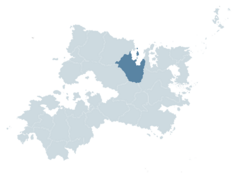 Location of Ogonkai (dark blue) In Audonia (light blue) | |
| Capital | None (de jure) Kinhara (de facto)[1] |
| Largest city | Minakyo |
| Official languages | Ogonkaic |
| Ethnic groups | Ogonkaic, Daxian |
| Religion | Golden god worship |
| Demonym(s) | Ogonkan, Ogonkaic |
| Government | Federal directorial republic |
• Representative of Seiha District | Kouno Kagetori |
• Representative of Fujisato District | Hori Hidetaka |
• Representative of Shimakoshi District | Inagaki Katsunaga |
• Representative of Okusen District | Aso Tadamasa |
• Representative of Kisore District | Wada Koreyori |
• Representative of Narazaki District | Sukeko Morikawa |
• Representative of Ryokuya District | Sugawara Suekata |
• Representative of Kaibe District | Matsura Yokitoshi |
• Representative of Kinhara District | Osa Ishimaki |
• Representative of Iwanobe District | Suko Kanamaru |
• Representative of Hakusan District | Urakami Ietada |
• Representative of Fukugan District | Niiro Arimichi |
| Establishment | |
• As the Golden Sea States | 991-1581 |
• As the Council of Ogonkai | 17 November 1690 |
• Current Charter | 1 December 1974 |
| Area | |
• Total | 1,303,126.62 km2 (503,140.00 sq mi) |
| Population | |
• 2035 estimate | 64,849,014 |
| GDP (nominal) | 2023 estimate |
• Total | $3.011 trillion |
• Per capita | $46.430 |
| Gini (2022) | high |
| Currency | Chyo (Ȼ) |
| Driving side | right |
Ogonkai, officially the Council of Ogonkai or the Ogonkaic Council, is a country in northern Audonia. To the west and south, it is bordered by Jazee, Kandara and Ankivara. To the east, it is bordered by Wonjin and Ugioh. With a population of 64 million, It comprises an area of 1,303,126km2 (503,104 sq mi) spread among its main continental landmass and hundreds of islands.
While lacking a federal capital, the National Council meets in the historic city of Kinhara. Minakyo is the nation's most populated city with an estimated population of six million; other major hubs include Aoyama, Kinhara, Yamatake and Sugihara. Divided among 12 districts and 3 special territories, roughly half of the nation's territory is extremely mountainous, concentrating its highly urbanized population and robust industry to its coastal areas and major islands.
While the territory that now comprises Ogonkai has historically been sparsely settled with major population centers instead concentrating south in Daxia and its neighboring territories, the first of many migrations towards the territory commenced roughly 13,000 years ago, with evidence of the first human habitation dating back to 20,000 years ago. After these migrations, widespread habitation of the territory began. Millennia later, as a way to defend against the increasingly more common Myanga Ayil Khanate incursions throughout the region, the villages and small fiefdoms that dotted the territory began crystallizing into their own independent kingdoms in the late tenth century.
Following a brief period of unified control from the city of Kinhara, the twelve kingdoms returned to being separate entities ruled by their own local lords until first contact with the Carto-Pelaxian Commonwealth forced the kingdoms into unification. The Charter of Unity was signed by the lords of the twelve realms in 1690 and was followed by an economic and population boom, consolidation of a newly-established upper class, forming of a cohesive national identity, and voluminous trade with both the Commonwealth and emerging Tierradorian trading companies.
After the dissolution of the Commonwealth, Ogonkai instaurated a policy of national self-reliance, termed "jishukoku", avoiding the conflicts that rocked the world at the time that lasted up to the start of the First Great War. The end of the period of isolation was followed by rapid modernization and staunch neutrality in the First and Second great wars. The rapid post-war economic boom precipitated a series of controversial anti-monarchic revolts that in 1974 culminated in the Itchou Revolutions, resulting in the replacement of the Charter of Unity with the current Chart of Solidarity that has remained in effect ever since.
Presently, Ogonkai is a federal directorial republic, in which the power to create laws and administrate the country is jointly exercised by the representatives of the twelve districts (collectively the National Council). While Ogonkai boasts high standards of living and a vibrant, advanced economy fueled by the automobile, service and electronics manufacturing industries, the nation struggles with high rates of inequality, discrimination (especially towards its non-ethnic Ogonkaic citizens), an stagnated political atmosphere and corruption. Internationally, Ogonkai is renowned for its global cultural footprint; Its globally influential culture is present in its pervasive animation, art, music and videogame industries, as well as an emerging robotics industry.
Etymology
The name for Ogonkai in the Ogonkaic language is written using the characters 黄金海. the characters "黄金", read "ogon", refer to gold, while the character "海", read "kai" refers to sea. Thus, the meaning of Ogonkai is "Golden Sea"; this is the source of the epithet "Land of the Golden Sea". Current consensus among historians establishes that this name was adopted during the brief spell of unification of the twelve kingdoms under the city of Kinhara, as the city shares the same characters (黄金).
Throughout the 17th century, the reading "Koganemi" was also used, but fell into disuse after the first contact with the Carto-Pelaxian Commonwealth; the explorers that came on the ships arrived at the sunset, and thus they called the land "Tierra del Mar Dorado" or "Terra do Mar Dorado".
Following contact with the Commonwealth, several newly-formed companies hailing from Tierrador established contact with the native population as well; in what is believed to be a mistranslation, the Tierradorian explorers mistakenly believed the name of the population to be "the Ogonkai", so they used the name "Apin Ogúúset" ("Far-away Ogonkan") to refer to its inhabitants.
History
What is a general overview of your country's path through history?
First migrations and mass settlement (11,000 BCE - 991 CE)
The first settlements of Ogonkai are overwhelmingly located in the south-eastern parts of the country, indicating that the flow of population emanated from the much more populous Daxian regions. Several smaller currents arrived from present-day Kandara and Jazee, forming a second cultural group in the region. There are several indices of confrontation between these two groups, as archeologists have found human remains that are thousands of years old and with bones skewed by various weapons.
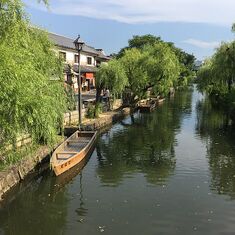
Broad trends across archeological sites indicate that by 200 CE the Kana people had been driven out of the disputed territories and retreated into the present-day Kandaran mountains, albeit small Kana villages survived in the Ogonkan mountains, becoming an isolated indigenous group, surviving to this day.
The first indices of civilization in the region take place in 501 CE, as a rich network of villages had sprung up throughout the coast and the Ishikari river located on the eastern side of the country. The fertile soils in this region allowed for rich harvests, which caused an explosion in population, although the rapidly developing western regions did not lag behind in development or population growth.
The regions to be inhabited last were the Home Islands (大島々; "Big islands"), with the first people to have settled all the three islands doing so as late as 600 CE. Nonetheless, due to their central location they quickly became a trade center in the region; commercial ties between the inhabitants of the islands and main island is believed to have started around 700 CE.
Formation of the twelve kingdoms and conflict with the Myanga Ayil Khanate (991 - 1581)
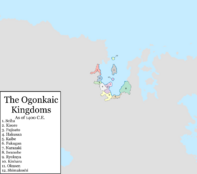
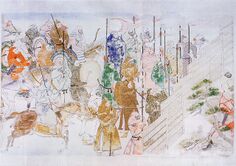
The increased trade and continuous back-and-forth migrations between the islands and regions of the mainland confounded the already high population growth and solidified the sea-based trade routes between the islands and the mainland, furthering the region's economic and technological prosperity. During this time, raids from the Myanga Ayil Khanate became more and more common and almost universally they were met with very little effective resistance, razing almost all of the villages that had settled far in land and massacring their inhabitants, effectively erasing them from the historical record.
This situation caused great chaos within the more developed coastal villages, sparking wars of self-preservation between local lords all throughout the region that culminated in the creation of twelve kingdoms that had arisen from this process of war.
By 1400 CE, the Khanate had reached the peak of its power, further strengthening the already common raids with more men and weapons. By this time, twelve kingdoms had been formed on the coasts of the region. The consolidation of these kingdoms allowed for a greater degree of societal organization, and the local kings soon began to mount armies to respond to the ever-increasing Khanate threat. The main places of combat were along the southern borders of the kingdoms of Narazaki, Fukugan and Hakusan, although significant engagements in kingdoms as far north as Iwanobe and Seiha were also reported.
While the southern kingdoms suffered many losses both in manpower and resources during this time, a tipping point in the Ogonkaic-Khanate Wars was the battle of Iwanobe, where the outnumbered kingdom managed to defeat the invading Khanate battallion by luring them into a river, ultimately causing their demise. News of the herculean achievement soon reached the lords of the other eleven kingdoms, invigorating their populations and revitalizing previously stagnant combat efforts.
By this time, the Kingdom of Kinhara was the richest of them all, thanks to its central location enabling commerce with all the other kingdoms. This accumulation of wealth resulted in great benefit, as it was able to leverage its economic weight to supply the other kingdoms with all the necessary materials to continue the war effort. Resources included gunpowder, food and metals, among others; this constant supply of materials both enabled the ever-weakening Khanate forces to be almost entirely driven out of the southern kingdoms by 1520 CE and significantly increased Kinhara's economic influence in the region, becoming an economic hegemon that more or less controlled the fate of the other kingdom's economies.
The downfall of the Myanga Ayil Khanate began in the 17th century, as much of their troops were demoralized and the upper ranks were consumed by corruption and frequent infighting. This instability brought an end to the Khanate invasions into the Ogonkaic kingdoms. However, taking notice of the widespread corruption within the ranks of the Khanate, emperor Teruyoshi of Kinhara bribed several Khanate battallions and bought their services with blocks of solid gold. This action virtually tripled Kinhara's combat strength and put it in a very favorable standing against the other kingdoms, battered and recovering from almost two centuries of constant war.
Kinhara-led unification of the twelve kingdoms (1602 - 1632)
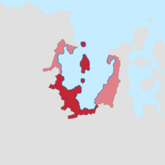
By the start of the 17th century, Kinhara had already begun incursions in all of the neighboring kingdoms, arguing that the debts the kingdoms assumed after purchasing supplies for the war efforts weren't being paid fast enough. While the kingdoms weren't able to put up any resistance, the battallions Kinhara had purchased the services of proved insufficient, as these troops were insufficiently trained in combat in the mountainous, forest regions that dominated the landscape. This incompetence significantly hindered Kinhara's momentum and, in the end, it was obligated to mount a force of its own to keep advancing.
As the southern kingdoms were in the process of being fully absorbed into Kinhara, the kingdoms of Seiha and Iwanobe negotiated favorable terms with Kinhara in exchange for sending troops to fight for it. Iwanobe and Seiha were allowed to keep a relative degree of independence, and they would be supplied with Kinharan men and weapons to conquer their respective northern regions, something both kingdoms had tried to do since the end of the war against the Khanate.
The last bastion of resistance was the kingdom of Hakusan that thanks to its mountainous geography was able to last a year longer before the walled city of Sugihara was finally overran, kickstarting the period of Kinhara rule over the former kingdoms.
The model of Kinharan domination of the former other kingdoms did not involve direct rule from Kinhara; rather, it involved a mix of intensification of trade between the former kingdoms and Kinhara, often to the disadvantage of the conquered territories, and the construction of a rich network of Kinharan operatives in each of the former kingdoms. Given the monopoly it had on trade throughout the region, most local lords and tradesmen buckled under the pressure and reluctantly accepted the new state of affairs.
Despite the fact Greater Kinhara had formed through conquest and economic dominance, this period of history was characterized by high cultural output. With the ever-looming Khanate threat gone, artistic expressions flourished. This period marked the creation of the foundations of what would eventually become Ogonkai proper, both in its societal expression and its cultural identity. Ogonkai's indigenous religion, worship of the golden god, became widespread throughout all of the former kingdoms at this time, thanks to Kinhara's influence.
Collapse of Greater Kinhara and last years of the kingdoms (1632 - 1690)
The downfall of Greater Kinhara began in 1620, with the formation of a secret group composed of disgruntled military lords, tradesmen and former nobility that had their societal standing and wealth uprooted by the Kinharan conquest. The group first met in the city of Minakyo, giving it its current historiographical name of the "Minakyo Group". The Minakyo Group covertly expanded its base of collaborators and informants to include all of the former kingdoms; among the ranks that had joined the Group there were local officials under control if Kinhara. This allowed the Group to siphon wealth and materials from Kinhara in preparation for its eventual uprising.
The vassal kingdoms of Seiha and Iwanobe, since their Kinhara-backed conquest of the northern regions, had been engaged in constant conflict with local indigenous lords and tribesmen. This forced Kinhara to divert funds and materials to those areas. Over time, this strain coupled with the silent siphoning of resources that had been happening for almost ten years diminished Kinhara's influence over the local lords, greatly wounding its system of control.

In 1631, Seiha experienced its first set of losses against the local tribes of the territory it had conquered. It requested more funds from Kinhara but it, Increasingly strained of resources, stopped supplying Seiha's war efforts. This enraged the upper class of Seiha that, aware of the existence of an insurrectionist group with roots all across the region, decided to covertly support it by facilitating access to Kinhara funds and bribing Kinharan officials settled in Seiha. After this, Seiha envoys arrived in Iwanobe, which was losing its own conquered territory, as well. Following a lukewarm meeting between the envoys and the King of Iwanobe, the King of Seiha personally met with the King of Iwanobe and promptly secured his support.
The process that lead up to the Battle of Kinhara was a slow build-up of weapons and men from all of the former kingdoms that culminated in the 1633 Battle of Kinhara with chief participation of the King of Seiha, Shigeaki Ando, who acted as the commander. During this battle, more than 30,000 combatants are estimated to have participated; accurate figures are hard to determine given much of the documentation was destroyed by the Minakyo Group itself. Teruyoshi, seeing that the enemy forces had surrounded the city and were about to break into its walls, committed suicide.
After learning of the news, his son, now the new emperor, surrendered. The Battle of Kinhara assured the end of Greater Kinhara and kickstarted a new era of reconstruction within Kinhara proper and the solidification of previous ties that had been built during the lead-up to the battle. The Minakyo Group's leaders would go on to become influential political figures, serving as chief advisors to the different leaders of all the kingdoms. Despite losing a substantial part of its economic power, Kinhara rebuilt rather rapidly by the hand of the new emperor, who pursued a policy of peace in order to not erode away the centuries of wealth and influence the kingdom had built.
Following the battle, Seiha and Iwanobe would join Kinhara to become the region's economic motors as much of the trade that Kinhara previously monopolized was now going through those two kingdoms. However, unable to keep consistent control over the regions they had conquered, Seiha and Iwanobe relinquished their claims. The other kingdoms, now no longer reliant on Kinhara, also saw the development of their own trade networks and a greater degree of economic self-reliance.
Contact with the Commonwealth, unification, and modernization (1690 - 1795)
The first contact with outside powers occurred in 1690 with the arrival of the Carto-Pelaxians. They established mostly in Minakyo, and from there they built commercial and cultural ties. Following their arrival, emerging Tierradorian and Alstinian companies also settled. They introduced Occidental items and culture to the various kingdoms, as well as religion: the Chantric Church became the main Christian branch in Ogonkai, amassing around 100,000 believers. During this time, Occidental customs about society and governance were also introduced; Occidental books were translated, and from there a new field of study arised: 西学 (Yogaku), or Occidental studies. This nourished a generation of students, and in these circles, unification of the 12 kingdoms became a popular thought. Among these thinkers was Konitane Kitagaki, now considered the founding father of Ogonkai, who coined the following phrase that would become the motto of the emerging unification movement:
Naturally marching towards destruction, men kill each other if there are no other men they must unite against. Thus, it is the natural fate of all of the inhabitants of all the realms to engage in an endless war. To contain these destructive impulses, all men must unite into a single man on a social level; unity will bring the strength needed to overcome the trials that have been put forth by the hand of fate, and unity will halt the slow, creeping march towards oblivion.
Among the kingdoms, a new upper class was emerging. Those who traded with the outsiders saw their profits skyrocket and, consequently, their social standing improve significantly. These people made a living out of crafting uniquely "Ogonkaic" products to trade with the Occidentals, thereby sparking interest about Ogonkai within Carto-Pelaxia, Tierrador and Alstin, as well as forming an image of what "Ogonkai" looks like, helping further develop the emerging national identity. Another important aspect of culture that emerged during this era is the Ogonkaic pursuit of culture and entertainment: the enriched and newly consolidated upper class funded cultural pursuits as well as entertainment. Soon enough, the rapidly increasing middle classes began adopting this behavior as well, giving rise to modern Ogonkaic culture's emphasis on enjoyment and individual happiness.
This new upper class had a vested interest in unifying the country. To them, unification meant a standardized currency and standardized tariffs, both of which would be tremendously beneficial for their enterprises. The Occidental powers took notice of this, and Carto-Pelaxian soldiers disembarked all across the capitals of the twelve kingdoms, demanding they met in Kinhara to unify; the monarchs, displaced in power by the trading class, reluctantly accepted unification.
There were attempts by some to stop this unification. The King of Iwanobe, the only king that actively supported unification, was almost assassinated on several occasions, but nonetheless, the Charter of Unity was signed, establishing the Council of Ogonkai as a single state where each king ruled their own realm but deliberated with the others to decide the fate on all the kingdoms.
After the Charter was signed, Ogonkai rapidly westernized; a single currency, the Chyo, was created, thousands of kilometers of road were paved, and the population skyrocketed. The new Royal Council adopted a policy of westernization, mainly drawing from Alstinian and Carto-Pelaxian academics and scientists. The kings, with the influence of the Yogaku academics (many of whom served as high-ranking advisors) desired to make the new country stand as an equal to the Occidental powers, kickstarting the modernization of the army and purchase of tens of thousands of weapons to have an army that could stand up to Occidental standards.
The Industrial Revolution arrived to Ogonkai after it did to Alstinia and Carto-Pelaxia. At first, it resulted in a new boom in all fields and areas of industry. Soon after, however, the Commonwealth of Carto-Pelaxia collapsed, which put all economic activities on a halt that caused the first economic crisis in modern Ogonkaic history. This enraged the population, which perceived that the pursuit of trade with the Occidental powers above all else had made the country reliant on them. Facing increasing pressure from growing mass protests and threats of armed rebellion by parts of the military, the Royal Council decided in a 7-5 ruling to end the ongoing relationships between Ogonkai and the Occidental powers, expelling the vast majority of Occidental academics that had been brought in over the previous years. This virtually eliminated all Ogonkaic-Occidental relations, although a small group of Alstinians working in industry, the sciences and government were allowed to remain.
"Jishukoku" period and southwards expansion (1796 - 1896)
With the closing off of most relations with the Occident, the "Jishukoku" (自主国; lit. 'independent country') period began. As the new policy settled in, many inward-looking reforms during this time were enacted. Chiefly among them was the promulgation of an Alstin-inspired legal code that established 12 independent legal circuits and a Supreme Tribunal headquartered in Kinhara. During this era the modernization of the armed forces continued, with the ultimate goal of creating a military as strong as that of the Occidental nations. As industrialization continued, the urban middle class consolidated. Given that contact with Occidental culture continued through the small enclave of Alstinians in the city of Minakyo, cultural relations continued, and from the mixing of Occidental and Ogonkaic culture emerged a new class of popular writers.
These writers formed the People's Influence Bloc and, as more of the urban middle class joined, it swelled in size to become a significant organization. It began organizing protests across Ogonkai's major cities and industrial centers. At its peak, the Bloc rallied around 25.000 people spread out across the country (by this time, Ogonkai had around a million inhabitants). Mounting pressure on production centers forced the upper classes to back the protests, which forced the Royal Council to negotiate with the Bloc.
The result of these negotiations were the establishment of twelve Regional Councils that served the 12 regions. These councils were voted for directly by eligible voters, and they served an advisory role to each region's monarch. They could also veto any decisions made by the monarch if a 75% (9-3) majority within the Regional Council was reached. While this was an important step in modernizing Ogonkai's political system, the powers of the Regional Councils were limited; modeled somewhat after Alstin's own voting laws, only literate males above the age of 25 had the right to vote. This drastically skewed the voting pool in favor of the upper classes, perpetuating their influence in the political system. This remained a point of contention between the middle and upper classes throughout the century and was the motivation for many episodes of popular unrest and confrontation that would happen afterward.
As industrialization intensified, the nation's population continued to grow at an increasingly accelerated rate. Beginning in 1815, many resource shortages (including manufacturing components and food) were observed. In a 1819 9-3 Royal Council decision, it was decided that Ogonkai would pursue a policy of colonization over the yet unclaimed Southern lands with the stated purpose of "promoting an organized environment for urban expansion and extraction of resources to match the growing population". The first of such expansions happened in 1820, followed by successive expansions in 1832 and 1846. While an stated aim of the project was to lighten the load of urban centers by promoting settlement in these new lands, influx was minimal and by 1890 the Special Territories only had a population of 130,000 (3.25% of Ogonkai's 4 million citizens by the end of the century).
End of Jishukoku and role in the Great Wars (1896 - 1943)
The start of the First Great War marked the end of the end of the Jishukoku policy as the Royal Council voted in a 7-5 decision to end the policy of isolation. Originally, it was a 5-7 decision, but the Regional Councils of Ryokuya and Kaibe vetoed the votes and flipped the result. Almost immediately after this, the Great War started that saw a spike in demand of raw supplies, plentiful in the newly-colonized special territories. This confounded the growth of the industrial sector and motivated settlement further south, primarily by some of the first waves of Thervalan and Kandaran migrants to settle in Ogonkai. While the Royal Council publicly had a neutral position in the conflict and called for peace within the war's different actors, it covertly sold arms and resources to Cartadania, Pelaxia (on the side of the Aliança) and Alstin (on the side of the Concordiae Powers).
The end of the war preceded the Great Depression, a period of economic downturn that impacted most of the world's major economies and crippled their industry after the end of the destructive war. While most nations linked to Burgundie's economic sphere of influence suffered the aftershocks of its own mild financial crisis, thereby halting their industry and economic activity somewhat, Ogonkai's own economy flourished during this period thanks to its deep economic relationship with Alstin, a country that instead of suffering the economic depression boom experienced a period of intensified economic growth. This growth splashed off into Ogonkai; in 1911, the Royal Council hired a group of Alstinian infrastructure experts with the aim of modernizing the country's transport system. In 1912, construction of the [[Hanei Bridges]] with the purpose of linking the regions of Okusen, and Kinhara, started. Finished in 1929, the bridges were the largest in the world at the time.
In 1930, Alstin entered into its own economic depression after the other economic powers had recovered from their own.
Itchou Revolutions and present day (1974-)
Geography
-
First lovely location
-
Second lovely location
-
Third lovely location
-
Fourth lovely location
-
Fifth lovely location
-
Sixth lovely location
What is the general explanation of how your country exists within the world?
Climate and environment
Is your country hot or cold?
Government and Politics
How is your country ruled or governed?
Executive
Who is responsible for making high level choices in your country? Does it have a President or King?
Legislative
Who decides the laws for your country? Is there political parties and a legislature?
Federal subdivisions
How is your country divided? Are there states or provinces, or is the country directly governed from the capital as a unitary state?
Politics
What political factions exist? Who has ruled predominantly?
Law
What kind of laws and legal system does your country employ?
Demographics
What kind of people live in your country?
Ethnicity
What ethnic groups make up your country?
Language
What language or languages do your country's people use? Are there any previously used languages no longer common? Are these languages native to your country or shared with another?
Religion
Religious affiliations in the XXX (20XX)
What do your country's people believe in religiously, if anything? How many groups are there?
Education
How many people in your country are educated?
Culture and Society
What do your people do, and what are they like?
Education
What is your country's education system like? How do the schools work? What do people think about education?
Attitudes and worldview
How do your country's people view life?
Kinship and family
How are families or kinship groups structured in your country?
Cuisine
What do your people eat?
Religion
What do your people believe? Rather than demographics, as above, think about how important religion is to your people and their view about their own and other religions. What is the relationship between the prevailing view and minority religious groups? Is it an official religion, and do any laws exist about free worship?
Arts and Literature
What type of art do your people make? Do they have a tradition of painted art, well-crafted television shows, or great music?
Sports
Does your country have any major sports leagues? What types of sports are played, both professionally and for fun by your country's people?"
Symbols
Are there any prominent symbols which are well known to represent your country?
Economy and Infrastructure
How does your country's economy work?
Industries and Sectors
What are the largest parts of your economy in terms of what they do?
Currency
What exchange systems are used within your country's economy?
Healthcare
How do people in your country procure medical care? How is it paid for?
Labor
How is labor organized within your country? Are there any social institutions or unions which deal with labor concerns?
Transportation
How do people in your country get around? Is there a major highway system as well as sea- and airports?
Energy
What type of energy keeps your nation going? Are you renewable or use fossil fuels, and if you are renewable, how recently did your country transition?
Technology
How advanced is your country? Is it an innovator, or does it largely import new developments?
Military
How large is your country's military? Is it large but poorly equipped or small and elite? Does your country have a martial tradition?
- ↑ While the current Charter establishes that there is no capital city, both the National Council and Supreme Tribunal are headquartered in Kinhara.



